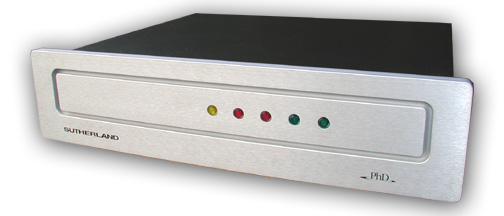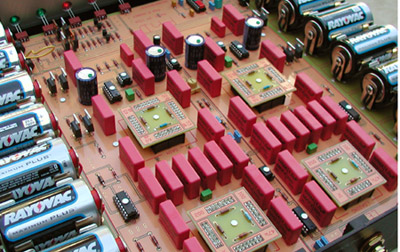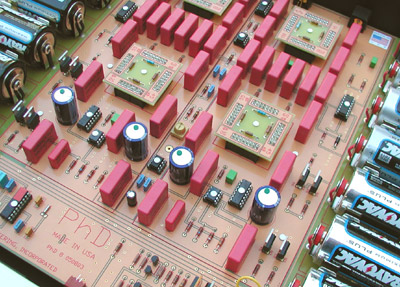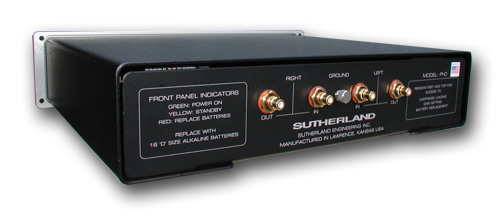You are reading the older HTML site
Positive Feedback ISSUE
12march/april 2004
sutherland
PhD phono stage - Batteries not included!
as reviewed by Dave Clark and Robert H. Levi

DAVE CLARK'S SYSTEM: LOUDSPEAKERS ELECTRONICS SOURCES CABLES ACCESSORIES
|
 The new Sutherland Ph.D.,
sourced from Acoustic Sounds, is the latest and greatest from Ron
Sutherland. Sutherland has a long history in audio. He introduced elegant,
"push-the-envelope" electronics that graced the audio world a few years ago.
Very cutting edge, and not inexpensive, Sutherland Audio products dropped
down below the radar for awhile before popping up again in the form of the
PH-1 from AcousTech, a joint venture with Acoustic Sounds. The PH-1 has
received much praise for providing outstanding sonics for a price that seems
reasonable considering the competition. Essentially a dual-mono phono stage,
though the channels share one circuit board, the Ph.D. is a marvel of
simplicity, elegance of design, and practicality.
The new Sutherland Ph.D.,
sourced from Acoustic Sounds, is the latest and greatest from Ron
Sutherland. Sutherland has a long history in audio. He introduced elegant,
"push-the-envelope" electronics that graced the audio world a few years ago.
Very cutting edge, and not inexpensive, Sutherland Audio products dropped
down below the radar for awhile before popping up again in the form of the
PH-1 from AcousTech, a joint venture with Acoustic Sounds. The PH-1 has
received much praise for providing outstanding sonics for a price that seems
reasonable considering the competition. Essentially a dual-mono phono stage,
though the channels share one circuit board, the Ph.D. is a marvel of
simplicity, elegance of design, and practicality.

Simplicity, you say? Ron eliminated the AC power supply by replacing it with sixteen D-cell batteries. True, changing the batteries is a bitch, as they do not slip into their cradles all that easily. It is also necessary to remove the very hefty U-shaped cover that slides onto the baseplate and is held in place by the screw-in feet. However, you probably won’t have to do this more than once or twice a year, as the batteries last for 400 to 700 hours of LP playback. That is a heck of a lot of music! You have probably already read Michael Fremer’s review in Stereophile and Wayne Garcia’s in TAS, so much of this is old news, but in case you missed them, let me say that the front panel has a series of LEDs to let you know what is going on. Two green LEDs (left and right channels) tell you that the unit is on and ready, one yellow light lets you know that the unit is going to turn off unless it sees a signal, and a red one says that the batteries are running low. (This comes on after 400 hours or so, but a good source told me that even with after it lights, you’ve got at least another 200 hours of playing time before the Ph.D. goes silent.) Also, even though the batteries die slow deaths from the get go, the unit will sound the same as long as there is enough DC to power the unit. Cool. Even cooler is the fact that the Ph.D. has no on/off switch. You won’t kill the batteries by leaving it on—it turns on automatically as the stylus hits the vinyl, and shuts off after twenty minutes without signal. Cooler still is the fact that the Ph.D. requires no warmup—it sounds as good as it ever will after a few seconds.
As for loading and gain, even slicker are the rotating boards that you simply pull out, turn to the appropriate setting, and reinsert. There are four boards—one per channel for gain and another pair for loading. No DIPS, no resistors, nada—simple, clean, and minimal as can be. Okay, you have to remove the bomb-shelter-like case to get to the boards, but how often will you need to change the settings? Set them, replace the top, and enjoy. Of course, you could leave the top off to enjoy the beautifully laid-out circuit and change the settings as you please. I found that the unit sounded pretty much the same with or without the top, though when removed, the top rings like a firebell on a hot summer day in drought-stricken SoCal. Read on for a few tweaks that bring the Ph.D. to the next level of performance.
The Ph.D.’s real selling point is that it is DC-powered via $15 worth of batteries. If this was a product coming out of Japan, we would probably be hearing that some other battery gives you better sound than the battery from the bunny, but Ron Sutherland and Chad Kassam told me that all batteries sound the same, so I installed twelve bunnies without looking back. If you want to spend the time and money to try every battery on the market to see if one is better, go for it and let me know. We will publish your findings. Ron and Chad have yet to hear of anyone doing this, but I am sure that in some dark, musty listening room there’s at least one audiophile that has way too much time on his hands.
By going the DC route, Ron has pretty much eliminated any noise, grounding issues, noise, hum, AC crap, etc. The Ph.D., while it is not the first DC phono stage, and is not likely to be the last, is as quiet as it can possibly be. I just got pure, clean music. I even tried to get the thing to hum by placing it and/or the interconnects near things that should have made it howl, and all I got was deafening silence.
Instead of noise, you get a very sophisticated and knowledgeable presentation that is true to the LP, with nothing added and nothing taken away. The Ph.D. is neither aggressive nor hard sounding, nor is it bright, wooly, or electronic. It has a liquid, grain-free presentation that is oh-so-sweet. It is not harmonically "tubey," so will not give you that tube bloom—for that you need tubes—but neither does it sound hard and metallic, as some solid state phono stages do. The Ph.D. renders voices with such a natural sense of purity and life-like presence that many of my favorite LPs are just too enjoyable. Playing Low and hearing either Alan Sparhawk or Mimi Parker emote with such gloom and despair can be a bit too much to take. Talk about being there! Every Low release features impeccable sound from an analog recording, done with minimalist techniques in a real room. Low records in a converted church, not a recording studio, and with the Ph.D. in my system, their music sounded better than it ever has.
The Ph.D. does lean a bit to the dark side, and does not throw detail upon detail into your face. However, the details are presented in a more natural, "relaxed" manner, with a lot less tension and angst. The Ph.D. is not for the analytical listener, or someone in the "I want to hear the resolution set to 11" camp. I have heard those kinds of phono stages, and find that you get resolution at the expense of long-term enjoyment. They tend to lack body and weight. The Ph.D. may add a little too much flesh to the bone, but details can be lost without detracting from the music, as opposed to losing the music in the details. When that happens, the point of the music is lost—how sad. Actually, it is sad that so many audiophiles prefer this kind of sound! With the Ph.D., if you want to hear all the details that real music possesses, you must focus a bit more and listen into the music. I other words, you must become an active participant in the event, not a bystander with front-row seats. You may be after this kind of experience, but I am not.
I want music that has a natural presence, I want rich texture, a rhythmically deep and powerful bass that is propulsive and true to the music (as opposed to loose and wooly, with no feeling to the notes as they move through the room, or that peters out with no sense or extension and power), a soundstage that extends out into the room, as opposed to being in another room altogether. I hate systems or components that push the music so far behind the front plane of the speakers that I might as well be outside looking in! I want to be there! The Ph.D. does that for me, with grace and ease. It will not startle you with an "in-your-face" sort of presentation, nor will it impress at first listen. Take your time and you will come to appreciate how it places the music in your room in a way that is involving and, though I hate to say it again, natural—nothing is added and nothing taken away.
 Listening
to "Clouds" on the HiM LP New Features, a complex exercise in rhythm
and dynamics, the Ph.D. did not shove it down my throat. Instead, the
performance unfolded naturally, with such force and pace that I had to get
up and dance—as bad as that might be to envision. Drums came across with an
amazing sense of scale and texture. (Him is the brainchild of drummer Doug
Scharin and features a who’s who of the alternative jazz scene.) Horns and
guitars cut through the wall of instruments, along with every other
instrument, including the kitchen sink. There was no hint of edge,
brightness, nor softness, and no absence of slam or dynamics—it was killer.
Ditto for Soldier of Midian by Badawi, which can come across with a
hard and upfront edge. Featuring a myriad of drums and samples, this LP is a
great way to see just how dynamic and propulsive your system is. The Ph.D.
reproduced this LP with an ease that had me cranking the volume ‘til all the
doors in the hose slammed shut in unison—not an easy feat in this household!
Listening
to "Clouds" on the HiM LP New Features, a complex exercise in rhythm
and dynamics, the Ph.D. did not shove it down my throat. Instead, the
performance unfolded naturally, with such force and pace that I had to get
up and dance—as bad as that might be to envision. Drums came across with an
amazing sense of scale and texture. (Him is the brainchild of drummer Doug
Scharin and features a who’s who of the alternative jazz scene.) Horns and
guitars cut through the wall of instruments, along with every other
instrument, including the kitchen sink. There was no hint of edge,
brightness, nor softness, and no absence of slam or dynamics—it was killer.
Ditto for Soldier of Midian by Badawi, which can come across with a
hard and upfront edge. Featuring a myriad of drums and samples, this LP is a
great way to see just how dynamic and propulsive your system is. The Ph.D.
reproduced this LP with an ease that had me cranking the volume ‘til all the
doors in the hose slammed shut in unison—not an easy feat in this household!
Michael Fremer and Bob Levi wrote about some shortcomings in their reviews of the Ph.D. Both found it lacking in dynamics, resolution, detail, and presence, and Fremer also found it to be a bit soft sounding. I am not going to discount what they heard or wrote—they wrote what they heard and heard what they wrote. Both are honest and knowledgeable reviewers, but with different systems, rooms, and preferences than mine. I certainly did not hear the things that they felt were faults with the Ph.D. I found that it offered all the detail and resolution one could want, though as I’ve said, none of this was done in a hyped or artificial way. It is true that the Ph.D. is not the phono stage for hall ambience and air out to the stratosphere, but having met Ron and Chad, I don’t think that that is what they were after. These guys love music, especially music that is fun and rocks! That the Ph.D. does.
I will say that interconnects made a really significant difference. Using Soundstrings or Nordost Quatro-fils was not the way to go, at least in my system, in my room, with my music, and to my ears (how’s that for a set of qualifiers?). While both are excellent cables in other situations, using either with the Ph.D. resulted in sound that was very reminiscent of what my colleagues reported—the sound was somewhat lacking in dynamics, with a tendency to be a tad darker and less resolving than the competition. It sounded really good, but was perhaps a touch too polite—not boring, but it gave the sense that there was a high-revving machine under the hood that was waiting to be released. It reminded me of my ’04 RX8—keep the revs under 5K and the car is fun to drive, but put the pedal to the metal and baby, hold on! Substituting the Audio Magic Clairvoyant 4D interconnects opened up the Ph.D. in every way. Pedal to the metal? You better believe it! Dynamics and slam moved up several notches, there was a much greater sense of "there-ness" and WAY more openness to the soundfield. It was a major improvement across the board.

What I think is going on is that since Ph.D. is so quiet that you really get to hear what the interconnects are doing to the music. This means that you should choose your interconnects very carefully. Do not fall into a trap of using what you think is the best or because it was the best with other components. In addition to getting the right interconnects, placing the Ph.D. on three DH Jumbo Cones with a smattering of Marigo Dots (chips, etc.) let me hear what this phono stage could really do. I got more of everything—resolution, detail, presence, dynamics, yadda, yadda—what you would expect when addressing the resonances that rob music of detail. I think Bob and Mike needed to play around with the Ph.D. a bit more. If you work the right combination with the Ph.D., things get really good really fast. I am not trying to suggest that Mikey doesn’t have a thing or two to teach me about reviewing and analog—he is so far ahead of me on the curve that I am a mere wisp in his wake—it is just that I feel that getting the Ph.D. to really shine needs effort. A few tweaks, and holy shit!
The Ph.D., properly tweaked, is a killer phono stage. It is dead quiet, does not require a fancy power cord or AC filtration, and is easy to use. I was so impressed with the Ph.D. that, back in January, I gave it a Brutus award for excellence and for "thinking outside the box." I also bought the review unit, and have yet—after hearing several phono stages that cost considerable more—to regret my purchase. There may be something better lurking in the shadows, and in a different system I might prefer something else, but for now, the Ph.D. is highly recommended. Dave Clark
Oh, and the Sutherland was my choice for a 2003 Brutus Award!
ROBERT H. LEVI'S SYSTEM LOUDSPEAKERS ELECTRONICS SOURCES CABLES ACCESSORIES
|
 Here
is a phono stage sure to please the Eveready bunny, with sixteen "D" cells
powering the unit for up to 800 hours of listening. The PhD is Sutherland’s
latest phono stage, built upon the knowledge gained from the PH-2000 and the
PH-1. It’s also his most expensive effort to date, built to challenge the
best stages available. I enjoyed my time listening to it because it let the
music sing, and was virtually uncolored and uncluttered with residual noise.
However, it compressed dynamics, pushed back the soundstage, slightly
reduced ambience, and was somewhat thin when compared with the best
available.
Here
is a phono stage sure to please the Eveready bunny, with sixteen "D" cells
powering the unit for up to 800 hours of listening. The PhD is Sutherland’s
latest phono stage, built upon the knowledge gained from the PH-2000 and the
PH-1. It’s also his most expensive effort to date, built to challenge the
best stages available. I enjoyed my time listening to it because it let the
music sing, and was virtually uncolored and uncluttered with residual noise.
However, it compressed dynamics, pushed back the soundstage, slightly
reduced ambience, and was somewhat thin when compared with the best
available.
The PhD’s biggest success is its low residual noise. After spending considerable time routing and rerouting my Soundstring single-ended interconnects, I was able to achieve a noise level equal to that of balanced connections on my reference phono stage, the E.A.R. 324. I believe all true audiophile phono stages need to be balanced, especially in this digital world, though not all are, including the most expensive. It just makes good sense. The Sutherland can be as quiet as advertised, but you must power down any digital components, pay attention to cable placement, and clean your cable connections. The unit was set at 55 dB of gain and 47k ohms—perfect for my Ruby 2H at .8mv output. All adjustments are internal, and require removing the feet and the case. At this price point, I’d prefer external controls.
In the last year, I have reviewed the Art Audio Reference, E.A.R. 324, and Hagerman Trumpet phono stages. I also had a Pass XONO for comparison. The best of the tube stages is the Art Audio. The best of the solid state designs, and the best overall, is the E.A.R.324. It is now my reference for phono sound and the benchmark for flexibility. The Sutherland and the E.A.R. are within a few hundred dollars of each other, and a shootout at the LP corral was inevitable.
Blues in Orbit (Classic Records CS8241) brings the Duke and his orchestra to full bloom. This is the new Quiex 200 gram edition, and it’s dynamic and detailed. On the Sutherland, it sounds textured and natural, neither dry nor wet, warm nor cool. The PhD is very neutral, with very good detail. It does not sound at all sterile. Many neutral-sounding components are boring, but not this one. It achieves a balancing act of texture, quiet, and colorlessness that is very appealing. Dynamics, on the other hand, are a bit lacking. The unit makes you want to turn up the volume to get more drive, but just when you get the pace and bloom in the horns and drums, you realize that the sound is too loud and too bright. The E.A.R. got the best from this recording, with correct oomph and blat from the instruments. It’s also very slightly sweet, which is never a problem, and probably more correctly reflective of the Benz sound. The E.A.R. had more air and ambience, and rendered the studio sound more accurately. With the PhD, the ceiling of the room seemed lower, and the venue less distinct. I used the same brand of interconnect and phono cables with both units, but could not, of course, match power cords.
 Linda
Ronstadt’s What’s New (Elektra 60260) is Nelson Riddle and his
orchestra, with vocals that were obviously recorded somewhere else. Both
phono stages were very complimentary to Ronstadt’s voice and to the string
sound. The strings were mellifluous on the PhD, with plenty of what
audiophiles crave, but there was more flesh-on-the-bones definition with the
E.A.R., giving one the impression of added strings and more complex
overtones. The PhD was less warm and sweet, though very pleasant and
detailed. It’s delightful to hear solid state designs get the string sound
and vocals right, without grain or edge, and the PhD is to be applauded for
this achievement. So is the E.A.R. On "What’ll I Do," the transitions
between soft and loud were more dramatic and realistic on the E.A.R. The PhD
did well with the soft parts, but was lacking on crescendos. No amount of
tweaking on my part could bring out the richness and pace I was looking for.
Linda
Ronstadt’s What’s New (Elektra 60260) is Nelson Riddle and his
orchestra, with vocals that were obviously recorded somewhere else. Both
phono stages were very complimentary to Ronstadt’s voice and to the string
sound. The strings were mellifluous on the PhD, with plenty of what
audiophiles crave, but there was more flesh-on-the-bones definition with the
E.A.R., giving one the impression of added strings and more complex
overtones. The PhD was less warm and sweet, though very pleasant and
detailed. It’s delightful to hear solid state designs get the string sound
and vocals right, without grain or edge, and the PhD is to be applauded for
this achievement. So is the E.A.R. On "What’ll I Do," the transitions
between soft and loud were more dramatic and realistic on the E.A.R. The PhD
did well with the soft parts, but was lacking on crescendos. No amount of
tweaking on my part could bring out the richness and pace I was looking for.
Country Gardens (Mercury 90219), containing the music of Percy Grainger, is both subtle and bold with power. Playing this treasured vintage Mercury LP was very telling. The PhD sounded very neutral. I heard a bit of the Telefunken mike glow, with good overtones and definition. Dynamics were slightly compressed, but the sound was very convincing. If I did not have the E.A.R. as reference, I would have been quite happy with the PhD, but the E.A.R. communicated the Mercury sound—the rosiny violins and the caramel ambience—more convincingly. Both stages were open and airy, but orchestral colors were more realistic on the E.A.R., and more "you are there." Both phono stages were grainless, and had similar surface noise characteristics. The PhD did not favor new versus vintage LPs, as many lesser solid state units do—it did not overemphasize flaws or enhance colorations. It also didn’t seem to lose any of its iron-fisted control on newer, more dynamic releases. It just sounded polite.
I played the next two LPs with the PhD set to maximum output: 60dBs of gain. Would dynamics increase? Would the gap close between the two phone stages?
Yes and no. Listening to Sonatas for Violin and Piano (Wilson Audio 8722) at 55 dB, the piano was slightly distant and soft, the violin smooth, uncolored, and polite. At 60dB, the sound was somewhat more dynamic, a bit less polite, and more realistic. The violin had more forte in the crescendos, while the piano had more bottom-octave sound. Switching to the E.A.R. revealed a still greater sense of you-are-there piano sound and a violin with sweet rather than neutral overtones. The sense of reality was again greater with the E.A.R. The PhD at 60dB closed the gap a bit, though not all the way. What do you do if you do not have a medium- to high-output MC cartridge? With a low-output MC, you may be up the audio creek.
 This
One’s For Blanton
(Pablo 2310721/Analogue Productions 015) features the Duke and Ray Brown in
a studio setting. The bass on the PhD was round and deep, with tan
overtones. It lacked the woody quality and pluck that I’m used to. The piano
had the appropriate jangly sound of a studio instrument, though it was
deeply recessed,. The instruments were almost alive in the room, but a bit
lacking in dynamics and slam. Through the E.A.R., the two instruments came
completely to life. Better slam and musical color were very apparent. I did
not have to listen long or hard to hear the realistic bloom of Ray Brown’s
big fiddle, as he plucked the notes with little subtlety. The jangle of the
piano keys was broader and bolder, with less of the distant feel I got from
the PhD. The E.A.R. clearly conveyed the energy of the two musical greats
better than the PhD, even at maximum output.
This
One’s For Blanton
(Pablo 2310721/Analogue Productions 015) features the Duke and Ray Brown in
a studio setting. The bass on the PhD was round and deep, with tan
overtones. It lacked the woody quality and pluck that I’m used to. The piano
had the appropriate jangly sound of a studio instrument, though it was
deeply recessed,. The instruments were almost alive in the room, but a bit
lacking in dynamics and slam. Through the E.A.R., the two instruments came
completely to life. Better slam and musical color were very apparent. I did
not have to listen long or hard to hear the realistic bloom of Ray Brown’s
big fiddle, as he plucked the notes with little subtlety. The jangle of the
piano keys was broader and bolder, with less of the distant feel I got from
the PhD. The E.A.R. clearly conveyed the energy of the two musical greats
better than the PhD, even at maximum output.
The PhD is not euphonic, and in no way detracts from the music in an onerous way. It suffers from a subtraction of texture and slam rather than addition of any coloration or noise. As J. Gordon Holt once said of hi-fi reproduction, "You never know what you’re missing." Without a reference that improves on the musical performance of the piece of gear at hand, your ear will tend to compensate for flaws, particularly those of the subtle, subtractive type like those of the PhD. The PhD has a musical sound, and its reduced dynamic drive may be pleasing to listeners with speakers, cartridges, or amplifiers that are big, bright, and powerful. It deserves a conditional recommendation, with a requisite audition before buying. Robert H. Levi

PhD phono stage
Retail: $3000
Acoustic Sounds
web address:
www.acousticsounds.com
